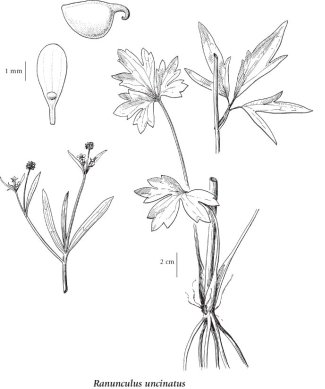Ranunculus uncinatus D. Don ex G. Don
little buttercup (woodland buttercup)
Ranunculaceae (Buttercup family)
Introduction to Vascular Plants
little buttercup (woodland buttercup)
Ranunculaceae (Buttercup family)
Introduction to Vascular Plants
Species Information
General:
Annual, biennial, or short-lived perennial herb from coarse, fibrous roots; stems single, erect, 20-60 (90) cm tall, simple or few-branched, stiff-hairy or nearly smooth, hollow.
Leaves:
Basal heart- to kidney-shaped, 3-parted to deeply 3-lobed, the blades 2-6 cm long, 3-8 cm wide, the segments again lobed, the ultimate segments elliptic to lanceolate, margins few-toothed, tips pointed to rounded or blunt, the stalks up to 20 cm long; stem leaves few, alternate, the upper transitional to linear-lanceolate bracts.
Flowers:
Inflorescence of few-flowered terminal and axillary cymes; flower stalks to 6 cm long; receptacle smooth; petals 5, distinct, yellow, 2-4 mm long, 1-2 mm wide, nectary on upper surface, the nectary scale as wide as long, smooth; sepals 5, bent back or sometimes spreading, 2-3.5 mm long, 1-2 mm wide, early deciduous, hairy; stamens 10-20; pistils (5) 10-30.
Fruits:
Achenes, several to many in a globe-shaped head 4-7 mm long, 4-7 mm wide, the achenes egg-shaped, 2-2.8 mm long, 1.6-2 mm wide, smooth or sparsely stiff-hairy, margins prominent, keeled; beaks persistent, lanceolate, 1.2-2.5 mm long, curved and hooked.
Notes:
Recognition of infraspecific entities does not appear warranted.
Illustration

If more than one illustration is available for a species (e.g., separate illustrations were provided for two subspecies) then links to the separate images will be provided below. Note that individual subspecies or varietal illustrations are not always available.
Illustration Source: The Illustrated Flora of British Columbia
Ecology
Ecological Framework for Ranunculus uncinatus
The table below shows the species-specific information calculated from
original data (BEC database) provided by the BC Ministry of Forests and Range.
(Updated August, 2013)
The table below shows the species-specific information calculated from
original data (BEC database) provided by the BC Ministry of Forests and Range.
(Updated August, 2013)
| Site Information |
Value / Class |
||
|
Avg |
Min |
Max |
|
| Elevation
(metres) |
931 | 0 | 2195 |
| Slope
Gradient (%) |
8 | 0 | 110 |
|
Aspect (degrees) |
183 | 0 | 360 |
| Soil
Moisture Regime (SMR) [0 - very xeric; 4 - mesic; 8 - hydric] |
5 | 2 | 8 |
| Modal
Nutrient Regime
Class |
D | ||
| #
of field plots species was recorded in: |
517 | ||
| Modal
BEC Zone Class |
CWH | ||
|
All BEC Zones (# of stations/zone) species was recorded in |
BAFA(2), BG(1), BWBS(5), CDF(21), CWH(122), ESSF(71), ICH(41), IDF(49), IMA(1), MH(2), MS(63), PP(7), SBPS(13), SBS(84), SWB(8) | ||
|
Source:
Klinkenberg 2013
|
|||
Habitat and Range
Moist meadows, streambanks and open woodlands in the lowland, steppe and montane zones; common in BC south of 56degreeN, rare in NW BC; N to AK, E to AB and S to NM, AZ and CA.Status Information
Synonyms
Synonyms and Alternate Names:
Ranunculus uncinatus var. parviflorus (Torr.) L.D. Benson